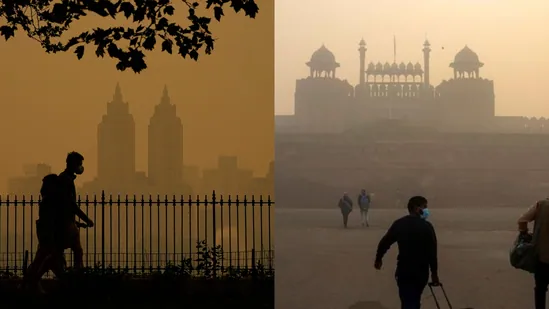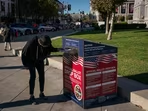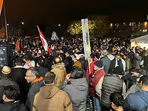Big apple in big trouble! Here's how New York City can learn a lesson or two from New Delhi's pollution battle
As New York City finds itself engulfed in a thick haze from Canadian wildfires, residents are facing a severe air quality crisis. The eerie orange skyline, reminiscent of Mars, is a stark reminder of the urgent need to address pollution. In this hazardous situation, New York can look east to find solution to current crisis.

New Delhi, a city notorious for its pollution levels can be an inspiration on how to combat smog and improve air quality. Let's delve into the details of this unprecedented situation and explore the valuable lessons that New York City can learn from the battle against pollution in New Delhi.
The Indian capital has to tackle winter smog every year due to several polluting factors like stubble burning and geographical conditions conflating together to make the air conditions worse for dwellers of the whole urban agglomeration.
Also read | Masks, air purifiers and indoor plants; What New Yorkers can learn from Delhites to survive the Canadian wildfire smoke

A Surprising Comparison: New York City vs Delhi Pollution
In a shocking revelation, the air quality in New York City was found to be a staggering 80% worse than that of Delhi, India—a city infamous for its pollution levels. This stark contrast highlights the severity of New York's situation and underscores the crucial lessons that can be learned from Delhi's battle against pollution.
IQair.com, a renowned air quality ranking site, made this alarming comparison around 2:30 p.m. on Thursday. Such a stark contrast highlights the severity of the situation in New York and underscores the urgent need for action.
Taking Cues from Delhi: Lessons in Battling Smog and Pollution
Amidst this unprecedented environmental situation, New York City can draw valuable lessons from Delhi's ongoing battle against pollution. From implementing emergency action plans to proactive measures based on forecasts, Delhi's experience can guide New York City in mitigating the impact of pollution and safeguarding the well-being of its residents.

What did Delhi do?
As the air quality in Delhi-NCR reached hazardous levels, the government implemented respective stage measures under the Graded Response Action Plan (GRAP). The Commission for Air Quality Management (CAQM) taking immediate action laid out the GRAP measures to combat pollution in the capital. It is essential to understand the significance of GRAP and its role in combating air pollution.
Understanding GRAP: An Emergency Response System
The Graded Response Action Plan (GRAP) is a comprehensive set of emergency measures designed to prevent further degradation of air quality in the Delhi-NCR region.
Developed after extensive deliberations between the Environment Pollution (Prevention and Control) Authority (EPCA), state government representatives, and experts, GRAP was approved by the Supreme Court in 2016 and officially notified in 2017. Its purpose is to institutionalize measures that need to be taken when air quality reaches critical levels.
Incremental Stages of GRAP
GRAP follows an incremental approach, triggering specific actions based on the Air Quality Index (AQI) thresholds. The plan encompasses four stages:
Stage 1: Poor Category (AQI: 201-300)
When the AQI falls within the "Poor" category, Stage 1 measures are activated. These actions include restrictions on certain activities and practices contributing to pollution.
Stage 2: Very Poor Category (AQI: 301-400)
As air quality worsens and enters the "Very Poor" category, Stage 2 measures come into effect. These stricter actions aim to curb pollution sources and reduce emissions.
Stage 3: Severe Category (AQI: 401-450)
When the AQI reaches the "Severe" category, Stage 3 measures are implemented. These measures are more stringent and focus on additional restrictions to control pollution levels.
Stage 4: Severe+ Category (AQI: >450)
The highest stage of GRAP is Stage 4, activated when the AQI surpasses the "Severe+" category. At this stage, drastic measures are undertaken to combat the alarming pollution levels and protect public health.

What can New York learn?
New York City can draw valuable lessons from Delhi's proactive approach, which includes implementing measures based on forecasts and taking pre-emptive action to prevent further deterioration of air quality. By adopting similar strategies and incorporating GRAP-like initiatives, New York City can mitigate the impacts of pollution and work towards improving the overall air quality.
As New York City faces its air quality crisis, the experiences and lessons from Delhi's ongoing battle against pollution can serve as a guiding light. By embracing innovative measures, implementing stricter regulations, and fostering public awareness and participation, New York City has the potential to overcome its current challenges and pave the way towards cleaner air for its residents.
Also read | New York City choking! An orange haze engulfs the concrete jungle, air quality plummets beyond 9/11 levels
In the face of global environmental issues, cities around the world can learn from one another's experiences and work together to combat air pollution. By sharing knowledge and adopting successful strategies, we can create a healthier and more sustainable future for all.
Disclaimer: The copyright of this article belongs to the original author. Reposting this article is solely for the purpose of information dissemination and does not constitute any investment advice. If there is any infringement, please contact us immediately. We will make corrections or deletions as necessary. Thank you.
Title:Big apple in big trouble! Here's how New York City can learn a lesson or two from New Delhi's pollution battle
Url:https://www.investsfocus.com









